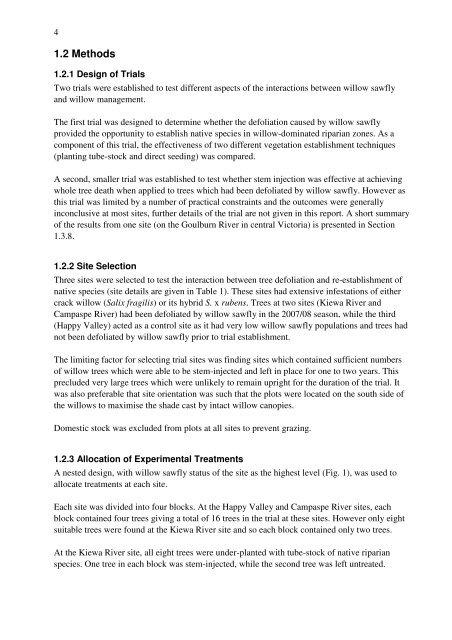Willow Sawfly Management Trials - Weeds Australia
Willow Sawfly Management Trials - Weeds Australia
Willow Sawfly Management Trials - Weeds Australia
Create successful ePaper yourself
Turn your PDF publications into a flip-book with our unique Google optimized e-Paper software.
41.2 Methods1.2.1 Design of <strong>Trials</strong>Two trials were established to test different aspects of the interactions between willow sawflyand willow management.The first trial was designed to determine whether the defoliation caused by willow sawflyprovided the opportunity to establish native species in willow-dominated riparian zones. As acomponent of this trial, the effectiveness of two different vegetation establishment techniques(planting tube-stock and direct seeding) was compared.A second, smaller trial was established to test whether stem injection was effective at achievingwhole tree death when applied to trees which had been defoliated by willow sawfly. However asthis trial was limited by a number of practical constraints and the outcomes were generallyinconclusive at most sites, further details of the trial are not given in this report. A short summaryof the results from one site (on the Goulburn River in central Victoria) is presented in Section1.3.8.1.2.2 Site SelectionThree sites were selected to test the interaction between tree defoliation and re-establishment ofnative species (site details are given in Table 1). These sites had extensive infestations of eithercrack willow (Salix fragilis) or its hybrid S. x rubens. Trees at two sites (Kiewa River andCampaspe River) had been defoliated by willow sawfly in the 2007/08 season, while the third(Happy Valley) acted as a control site as it had very low willow sawfly populations and trees hadnot been defoliated by willow sawfly prior to trial establishment.The limiting factor for selecting trial sites was finding sites which contained sufficient numbersof willow trees which were able to be stem-injected and left in place for one to two years. Thisprecluded very large trees which were unlikely to remain upright for the duration of the trial. Itwas also preferable that site orientation was such that the plots were located on the south side ofthe willows to maximise the shade cast by intact willow canopies.Domestic stock was excluded from plots at all sites to prevent grazing.1.2.3 Allocation of Experimental TreatmentsA nested design, with willow sawfly status of the site as the highest level (Fig. 1), was used toallocate treatments at each site.Each site was divided into four blocks. At the Happy Valley and Campaspe River sites, eachblock contained four trees giving a total of 16 trees in the trial at these sites. However only eightsuitable trees were found at the Kiewa River site and so each block contained only two trees.At the Kiewa River site, all eight trees were under-planted with tube-stock of native riparianspecies. One tree in each block was stem-injected, while the second tree was left untreated.
















